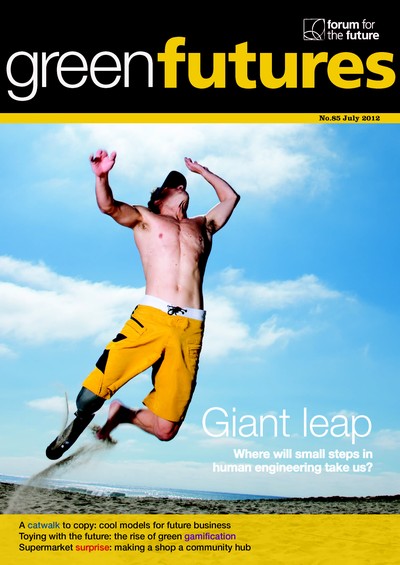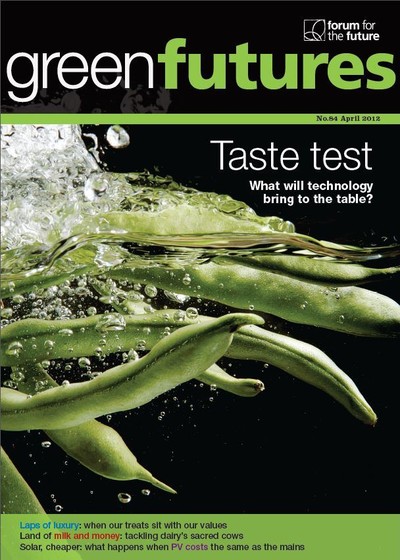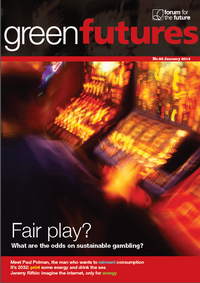Green Futures i — April 2012, #84

Green Futures
Green Futures is the leading magazine on environmental solutions and sustainable futures. Founded by Jonathon Porritt in 1996, it is published by Forum for the Future.
- 199 (51)
- United Kingdom
- Four issues a year
- First issue 1996
It used to be so simple.
Being green meant loving the local, organic, human-scale stuff. You weren’t totally anti-tech of course – it’s hard to weave your own solar module – but when in doubt, natural was best. Sometimes, it seemed almost easier to define greens by what they were against: factory farming, ‘Frankenstein’ foods, conspicuous consumption of all kinds… It was a familiar, not to say comfortable, niche.
But it’s one that’s been blown wide open.
A new wave of thinkers and scientists are arguing that we need to embrace some starkly unnatural technologies if we are to survive, let alone prosper. In ‘Taste test’ [p20], Andrew Purvis unveils a future in which we feed the world on a diet of test tube burgers and print our own sushi. And in ‘Land of milk and money’ [p16], Huw Spanner dares to question the sacred, er, cow of traditional dairy farming – where Buttercup grazes contentedly on green pastures in the fresh spring air. Instead, the future might just stand in serried ranks of beasts confined all year round in vast ‘megadairies.’
Neither of these visions is inevitable – far from it. But if the mere idea is enough to put you off your supper, consider an all too likely future of soaring commodity prices, spiralling malnutrition, food riots, and, yes, runaway climate change. Sounds like typical green scare mongering? Well, as we go to press, the sober-suited OECD has delivered a stinging slap in the face to complacency, warning that we could be on track for a catastrophic 6°C of global warming by 2050, unless we make some uncharacteristically dramatic changes to business as usual.
In this light, thinking out of the box – and the comfy niche – isn’t just courageous. It’s compulsory. Greens also used to have a soft spot for simple pleasures: for living according to Gandhi’s precept that “there is enough on earth for everyone’s needs – not everyone’s greed.” So what is Anna Simpson doing singing the praises of a life of luxury [‘How to spend it’, p28]?
One intriguing answer is that, increasingly, the ‘luxury sector’ is embracing just those values once ascribed to environmentalists: hand crafted, made to last, sourced with care and with respect to the makers.
And if you find all this a bit unsettling, you might take comfort from Roger East’s investigation into the rise and rise of solar power [‘Is solar the new normal?’, p30]. This may have been a touch eclipsed of late by wrangling over feed-in tariffs, and the high-profile collapse of a couple of major players. But, as East points out, none of this has slowed the dramatic fall in solar’s costs.
We’re now at a point where, in some circumstances at least, the price of solar is on a par with the grid as a whole. And that could unleash a growth in the market that puts even its recent surge in the shade. I’m writing these words on the morning of the spring equinox. Appropriately enough. Because, in almost any kind of future, it seems, the sun is up.
What do you think of this issue?
Sign up or Log in to join the discussion.
Recent activity
- 05 Nov, 2019 Added to pile by johanntasker
- 08 May, 2012 New cover uploaded by prinashah
- 08 May, 2012 Added to Magpile by prinashah




